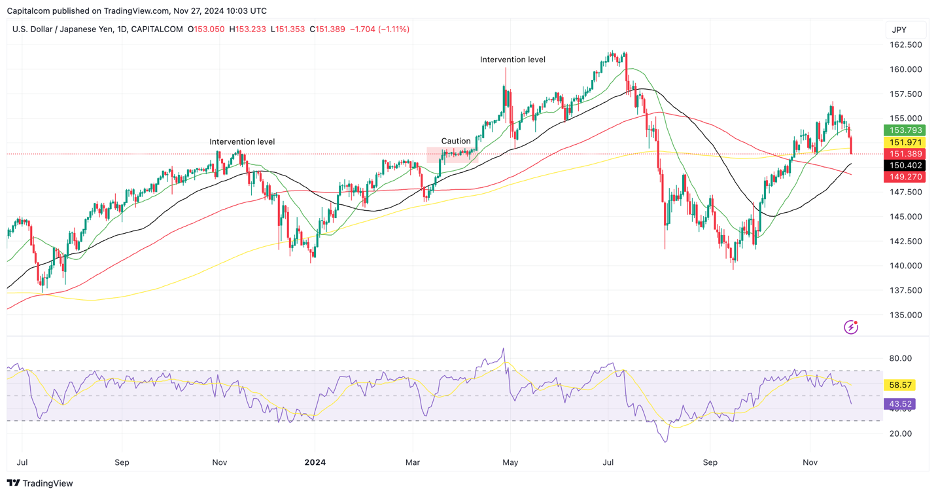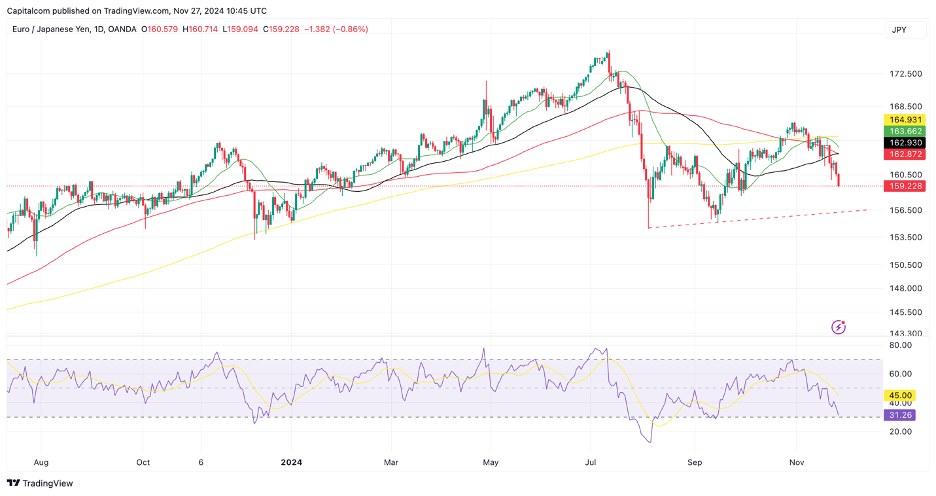Whilst most major central banks in developed economies are looking to continue cutting rates, the Bank of Japan may hike rates again when they meet in December. The playing field is very different as Japan has struggled with low inflation for a decade, even during the post-covid economic recovery. During this time, headline inflation remained below 5% in Japan, when the US, Europe and UK were seeing CPI figures closer to 10%. As a response, a strict rate hiking cycle ensued in most developed economies, but the Bank of Japan (BoJ) left rates unchanged at -0.1% throughout.
This led to a continued depreciation in the Japanese yen as the rate differential meant that borrowing in yen and using them to buy other currencies was highly lucrative. As a result, the yen saw continued depreciation throughout 2023 and the first half of 2024, taking USDJPY to above 160 and prompting several rounds of FX intervention from Japanese officials.
But the tables started turning in summer when the European Central Bank (ECB), Bank of England (BOE) and Federal Reserve started to consider cutting rates to rebalance their economies after a period of restrictive policy to combat soaring inflation. At the same time, the Bank of Japan was starting to accept that the Japanese economy was experiencing increasing domestic inflation – which had been attributed to external factors throughout most of the post-covid recovery. This led to a need to gradually increase their base rate, taking it from -0.1% to the current 0.25%.
Clearly there is still a big rate differential which does not play in favour of the yen but there is expectation that the BOJ could increase rates by 25 basis points again in December, and this has been attracting buyers to the Japanese currency once again. Alongside a reversal in the US dollar over the past few days, USD/JPY has dropped 3.5% in the last 10 days, closing in on the 150 level once again.
USD/JPY daily chart
Past performance is not a reliable indicator of future results.
The same is happening against the pound and the euro where markets are rebalancing the rate differentials as both the BOE and ECB are expected to continue cutting rates over the coming year. The pullback could intensity further in EUR/JPY as the ECB is expected to be able to continue gradually reducing rates over the next few months. Markets are currently pricing in 130 basis points of cuts by June next year, which would take the base rate to just under 2%. The BOE and Fed are only expected to cut around 50 basis points in that same time period.
The expectation of less restrictive monetary policy in Europe could weaken the euro further. This could mean continued downside for EUR/JPY if the Bank of Japan is seen as hawkish over the coming months. The pair has dropped back below its key simple moving averages (20, 50, 100, 200) which suggests buyers will find resistance attempting to reverse higher, and therefore the path of least resistance remains lower for the time being. In the absence of any unexpected hawkishness from the ECB or dovishness from the BOJ then EUR/JPY could return to the lows seen in September below 156.50, at which point an ascending trendline from the 2024 lows could offer some support.
EUR/JPY daily chart
Past performance is not a reliable indicator of future results.
Capital Com is an execution-only service provider. The material provided in this article is for information purposes only and should not be understood as investment advice. Any opinion that may be provided on this page does not constitute a recommendation by Capital Com or its agents. We do not make any representations or warranty on the accuracy or completeness of the information that is provided on this page. If you rely on the information on this page, then you do so entirely at your own risk.
- English (USA)
- English (India)
- English (Canada)
- English (Australia)
- English (South Africa)
- English (Philippines)
- English (Nigeria)
- Deutsch
- Español (España)
- Español (México)
- Français
- Italiano
- Nederlands
- Português (Portugal)
- Polski
- Português (Brasil)
- Русский
- Türkçe
- العربية
- Ελληνικά
- Svenska
- Suomi
- עברית
- 日本語
- 한국어
- 简体中文
- 繁體中文
- Bahasa Indonesia
- Bahasa Melayu
- ไทย
- Tiếng Việt
- हिंदी
Japanese Yen Strengthens as BOJ Expected to Hike Rates Again, EUR/JPY in Focus
Published 27/11/2024, 13:46
Japanese Yen Strengthens as BOJ Expected to Hike Rates Again, EUR/JPY in Focus
Latest comments
Loading next article…
Install Our App
Risk Disclosure: Trading in financial instruments and/or cryptocurrencies involves high risks including the risk of losing some, or all, of your investment amount, and may not be suitable for all investors. Prices of cryptocurrencies are extremely volatile and may be affected by external factors such as financial, regulatory or political events. Trading on margin increases the financial risks.
Before deciding to trade in financial instrument or cryptocurrencies you should be fully informed of the risks and costs associated with trading the financial markets, carefully consider your investment objectives, level of experience, and risk appetite, and seek professional advice where needed.
Fusion Media would like to remind you that the data contained in this website is not necessarily real-time nor accurate. The data and prices on the website are not necessarily provided by any market or exchange, but may be provided by market makers, and so prices may not be accurate and may differ from the actual price at any given market, meaning prices are indicative and not appropriate for trading purposes. Fusion Media and any provider of the data contained in this website will not accept liability for any loss or damage as a result of your trading, or your reliance on the information contained within this website.
It is prohibited to use, store, reproduce, display, modify, transmit or distribute the data contained in this website without the explicit prior written permission of Fusion Media and/or the data provider. All intellectual property rights are reserved by the providers and/or the exchange providing the data contained in this website.
Fusion Media may be compensated by the advertisers that appear on the website, based on your interaction with the advertisements or advertisers.
Before deciding to trade in financial instrument or cryptocurrencies you should be fully informed of the risks and costs associated with trading the financial markets, carefully consider your investment objectives, level of experience, and risk appetite, and seek professional advice where needed.
Fusion Media would like to remind you that the data contained in this website is not necessarily real-time nor accurate. The data and prices on the website are not necessarily provided by any market or exchange, but may be provided by market makers, and so prices may not be accurate and may differ from the actual price at any given market, meaning prices are indicative and not appropriate for trading purposes. Fusion Media and any provider of the data contained in this website will not accept liability for any loss or damage as a result of your trading, or your reliance on the information contained within this website.
It is prohibited to use, store, reproduce, display, modify, transmit or distribute the data contained in this website without the explicit prior written permission of Fusion Media and/or the data provider. All intellectual property rights are reserved by the providers and/or the exchange providing the data contained in this website.
Fusion Media may be compensated by the advertisers that appear on the website, based on your interaction with the advertisements or advertisers.
© 2007-2025 - Fusion Media Limited. All Rights Reserved.
